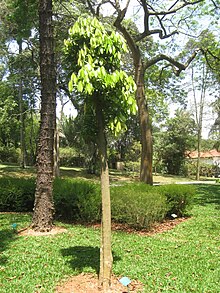
The flowering plant family Lauraceae, the laurels, includes the true laurel and its closest relatives. This family comprises about 2850 known species in about 45 genera worldwide. They are dicotyledons, and occur mainly in warm temperate and tropical regions, especially Southeast Asia and South America. Many are aromatic evergreen trees or shrubs, but some, such as Sassafras, are deciduous, or include both deciduous and evergreen trees and shrubs, especially in tropical and temperate climates. The genus Cassytha is unique in the Lauraceae in that its members are parasitic vines.

Safrole is an organic compound with the formula CH2O2C6H3CH2CH=CH2. It is a colorless oily liquid, although impure samples can appear yellow. A member of the phenylpropanoid family of natural products, it is found in sassafras plants, among others. Small amounts are found in a wide variety of plants, where it functions as a natural antifeedant. Ocotea pretiosa, which grows in Brazil, and Sassafras albidum, which grows in eastern North America, are the main natural sources of safrole. It has a characteristic "sweet-shop" aroma.

Ocotea is a genus of flowering plants belonging to the family Lauraceae. Many are evergreen trees with lauroid leaves.

Dipteryx is a genus containing a number of species of large trees and possibly shrubs. It belongs to the "papilionoid" subfamily – Faboideae – of the family Fabaceae. This genus is native to South and Central America and the Caribbean. Formerly, the related genus Taralea was included in Dipteryx.

Amburana cearensis is a species of timber tree in the family Fabaceae. This plant is native to Argentina, Bolivia, Brazil, Paraguay, and Peru. It is threatened by habitat loss.

Dalbergia odorifera, or fragrant rosewood, Chinese rosewood, is a species of legume in the family Fabaceae. It is a small or medium-sized tree, 10–15 metres (33–49 ft) tall. It is endemic to China and occurs in Fujian, Hainan, Zhejiang, and Guangdong.
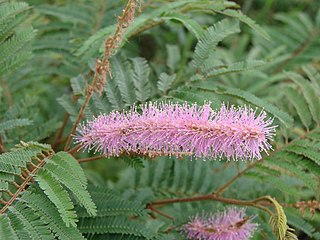
Mimosa verrucosa, commonly known as jurema-branca or jurema-de-oeiras, is a species of legume of the genus Mimosa, in the common bean family, Fabaceae.
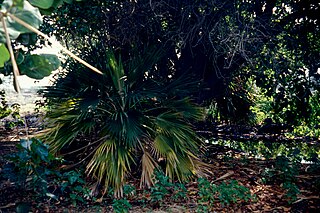
Pritchardia affinis, the Hawai'i pritchardia, is a species of palm tree that is endemic to the Hawaiian Islands. Wild populations currently exist on the leeward side of the Island of Hawaiʻi. It was most likely cultivated by Native Hawaiians, so its exact native range is uncertain. P. affinis reaches a height of 10–25 m (33–82 ft). It is threatened by rats and pigs, which damage the trees and eat the seeds before they can grow. It is a federally listed endangered species of the United States. Its fruit was reportedly the preferred food of the now-extinct ula-ai-hawane—a niche that has been seemingly filled by the introduced lavender waxbill.

Balfourodendron riedelianum, known as marfim in Portuguese, is a species of flowering tree in the rue family, Rutaceae. It is native to Argentina, Brazil, and Paraguay.
Bourreria baccata is a species of plant in the family Boraginaceae. It is native to Caribbean islands including Jamaica, and also to parts of north and South America. Common names include cherry, currant tree, poisonberry, chink, and bodywood.
Ocotea basicordatifolia is a species of Ocotea in the plant family Lauraceae.
Ocotea catharinensis is a member of the plant family Lauraceae. It is a slow-growing evergreen, a valuable hardwood tree of broad ecological importance, and it is threatened by habitat loss and by overexploitation for its timber and essential oils.
Ocotea cymbarum is a species of Ocotea in the plant family Lauraceae. It is an evergreen tree found in Brazil, Colombia, French Guiana, Guyana, Suriname, and Venezuela.
Ocotea langsdorffii is a species of plant in the family Lauraceae.

Ocotea porosa is a species of plant in the Lauraceae, often placed in the related genus Phoebe. It is commonly called imbuia or Brazilian walnut because its wood resembles that of some walnuts. The tree is a major commercial timber species in Brazil, used for high-end furniture, mostly as decorative veneers, and as flooring. The wood is very hard, measuring 3,684 lbf on the Janka scale. The wood is also fragrant with hints of nutmeg and cinnamon. The tree is also a popular horticultural tree in subtropical regions of the world. In its native habitat it is a threatened species.
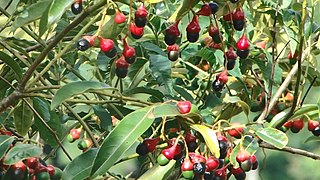
Ocotea puberula is a species of evergreen tree in the plant genus Ocotea of the family Lauraceae. It is found in Argentina, Brazil, French Guiana, Guyana, Mexico, Peru, and Suriname.

Virola surinamensis, known commonly as baboonwood, ucuuba, ucuhuba and chalviande, is a species of flowering plant in the family Myristicaceae. It is found in Brazil, Costa Rica, Ecuador, French Guiana, Guyana, Panama, Peru, Suriname, and Venezuela. It has also been naturalized in the Caribbean. Its natural habitats are subtropical or tropical moist lowland forests, subtropical or tropical swamps, and heavily degraded former forest. Although the species is listed as threatened due to habitat loss by the IUCN, it is a common tree species found throughout Central and South America.
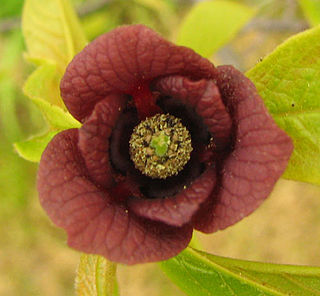
Magnoliids are a group of flowering plants. Until recently, the group included about 9,000 species, including magnolias, nutmeg, bay laurel, cinnamon, avocado, black pepper, tulip tree and many others. The group is characterized by trimerous flowers, pollen with one pore, and usually branching-veined leaves.
Cinnamomum mercadoi (kalingag) is a small tree, about 6 to 10 metres high, with a thick, aromatic bark. The plant part of the family Lauraceae, which contains about 45 genera and 2000-2500 species, and is related to the culinary cinnamon, sassafras, and bay tree. The plant is indigenous to the Philippines, where it grows best in forests at low and medium altitudes that sometimes ascend to 2,000 metres (6,600 ft). C. mercadoi is unusual in the cinnamon family in that its essential oil consists large amounts of safrol, whereas other oils of cinnamon contain cinnamaldehyde. It is currently listed in the International Union for Conservation of Nature (IUCN) Red List as "vulnerable" due to the overharvesting and the continuous loss of the Philippine forests.
Prunus havardii, called Havard's wild almond or Havard's plum, is a rare North American species of shrub tree native to western Texas in the United States and to northern Chihuahua across the Río Grande in Mexico. It is in the genus Prunus in the rose family, Rosaceae.
